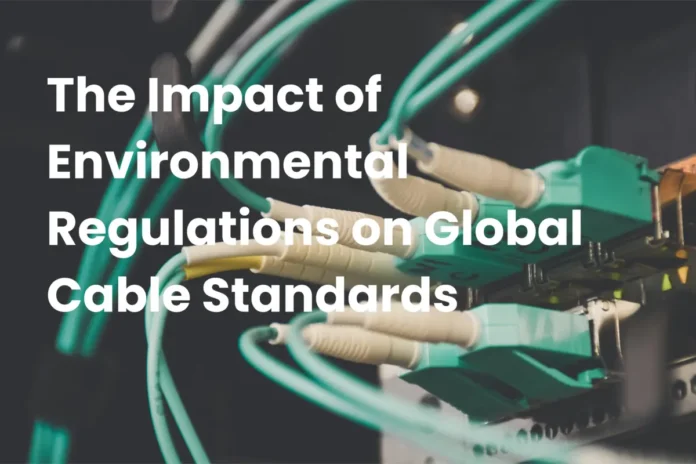At Industry level, the world turns from industries of steel and smoke to an industry where governments and regulatory authorities have issued topical and numerous stringent environmental regulations that affect the materials, manufacturing, and disposal of cables. The stricter legislation on products will create an injury-free, green products environment and give an impetus to further innovative sustainable materials and energy-efficient processes to develop.
With global guidelines like RoHS, REACH, and ISO environmental certifications for cable manufacturers, it is expected to go a long way towards achieving sustainability and also avoiding market barriers. Companies like Ducab have become leaders in adopting eco-friendly materials, resource-efficient production processes, and strict compliance measures in their cable manufacturing practices.
1. Key Environmental Regulations Affecting the Cable Industry
There are some international regulatory frameworks that enforce certain cable materials, manufacturing, and sustainability standards.
- a) RoHS
RoHS was designed to limit the use of toxic substances like lead, mercury, cadmium, and brominated flame retardants from electrical and electronic cables.
In a bid to conform to European market regulation, manufacturers are adequately induced to replace such materials with safer and sustainable alternatives.
- b) REACH
Through REACH, the use of dangerous chemicals in cable manufacture is regulated, ensuring such substances pose no hazards when handled or disposed of.
Cable companies must register chemicals that they use in insulation, sheathing, and conductor production under REACH.
- c) ISO 14001 Environmental Management Certification
ISO 14001 lays down a global benchmark for sustainable practices in manufacturing and waste management.
In compliance with ISO 14001, cable companies are able to reduce the impact of their operations in emissions, energy usage, and recycling.
- d) Low Smoke Zero Halogen (LSZH) Standards
In many markets, LSZH cables must be used in order to reduce the toxic emissions usually generated during fire, making them suitable for public buildings, railways, and tunnels.
They generate lower smoke and no corrosive gases, thus assisting in fire safety.
- e) U.S. National Electrical Code (NEC) and IEC Standards
The NEC and IEC establish the rules for safety and performance of electrical installation cables.
They ensure energy efficiency and protection from fire and the environment.
The existence of these regulations is one means whereby manufacturers can foster the safety and sustainability of their product in the marketplace.
2. The Impact of Regulations on Cable Materials and Design
Environmental regulations are now guiding the creation of safer and more sustainable materials for cable manufacturing.
- a) Replacement of Hazardous Materials
Halogen-free recyclable polymers are now replacing traditional lead-based and PVC insulation.
Meanwhile, non-phthalate plasticizers also render the cables flexible with less toxicity.
- b) Environmentally Friendly Conductors and Insulation
Recycled copper and aluminum are used in abundance to lessen the environmental effects of mining.
Biodegradable insulation materials and bio-based alternatives are being explored.
- c) Lesser Carbon Footprint in Manufacturing
Energy-efficient technologies in manufacturing like AI process optimization cause reduction in the amount of green gas emissions.
The factories are using a closed-loop recycling system that allows the reuse of scrap materials.
Besides addressing environmental issues, the developments in these materials also enhance cable durability and performance.
3. Sustainable Manufacturing Practices in Cable Production
Environmental regulations are now guiding the creation of safer and more sustainable materials for cable manufacturing.
- a) Replacement of Hazardous Materials
Halogen-free recyclable polymers are now replacing traditional lead-based and PVC insulation.
Meanwhile, non-phthalate plasticizers also render the cables flexible with less toxicity.
- b) Environmentally Friendly Conductors and Insulation
Recycled copper and aluminum are used in abundance to lessen the environmental effects of mining.
Biodegradable insulation materials and bio-based alternatives are being explored.
- c) Lesser Carbon Footprint in Manufacturing
Energy-efficient technologies in manufacturing like AI process optimization cause reduction in the amount of green gas emissions.
The factories are using a closed-loop recycling system that allows the reuse of scrap materials.
Besides addressing environmental issues, the developments in these materials also enhance cable durability and performance.
4. Challenges in Meeting Global Environmental Regulations
An important part of this is that, with the advantages, the drawbacks can be seen to slow down the implementation of eco-friendly cable production in manufacturers.
- a) High Compliance Costs
There is huge dollar input into research and development for the materials for RoHS-compliant and LSZH cables.
Investments should be made in new machines and capacity training programs to cater to green production moves.
- b) Complex Supply Chain Management
Supplier monitoring with regard to REACH and RoHS regulations is extremely demanding.
It requires precision and transparency in all practices when tracking extraction-to-product materials.
- c) Balance Performance with Sustainability
A proportion of green materials vary in electrical performance, thus design modifications needed.
Manufacturers should also develop those be economical in terms of cost but great in performance and safety potential.
Challenges must be addressed for the industry to realize green development fully without sacrificing efficiency.
5. The Future of Cable Manufacturing in an Environmentally Regulated World
The future of cable manufacturing will be influenced by the following factors:
- a) AI and Smart Manufacturing for Compliance
Machine learning models will optimize material usage to minimize waste and ensure compliance.
AI-based quality control systems have improved, resulting in real-time on-line defect analysis and energy efficiency improvements.
- b) Development of Circular Economy Initiatives
Closed-loop recycling systems will become the norm across the industry to minimize wastage of resources.
Manufacturers will have to adapt systems to design cables for recyclability and hence promote the ease of disassembly and reuse.
- c) New Expansion of Bio-based and Recyclable Materials
Such innovations, together with other progress, will be natural biodegradable insulation, plantderived polymer that will replace the traditional artificial materials.
Advances in graphene-based conductors could make them more efficient and enhanced, reducing raw material extraction.
- d) Increasing Global Regulatory Strengths and Compliance Technologies
This would imply using cutting-edge technology such as digital tracking, including blockchain, to improve traceability while ensuring compliance with ever-changing environmental protective laws.
These would ensure the continuous advancement of cable manufacturing into sustainability, efficiency, and legal compliance.
Conclusion:
From October 2023 and onwards, the environment-oriented regulations start redrawing global cable standards, fostering factories to produce cables that are manufactured safely, environmentally green, and high performance. RoHS, REACH, LSZH, ISO 14001 reduce the environmental footprint, hence pushing forward raw material applications and sustainable production technologies.
Ducab is a prime example of a company establishing an avenue of using green technologies, AI-driven process optimization, and sustainable materials that meet regulatory requirements and provide high-end energy-efficient cable solutions. It implies that cable manufacturers should similarly leapfrog in the implementation of innovative and eco-friendly practices into their production processes as these norms continue to morph.
FAQs: Environmental Regulations and Global Cable Standards
- What key environmental regulations affect cable manufacturing?
Regulations like RoHS, REACH, LSZH Standards, and Environmental Management System ISO 14001 set parameters for the safer and sustainable manufacturing process of cables.
- How does RoHS affect the materials used in cable work?
RoHS specifies hazardous substances, including lead, cadmium, and mercury, which should not be used; manufacturers must therefore find suitable substitutes that pose less of a risk to health and the environment.
- What are the benefits of LSZH cables?
Low Smoke Zero Halogen (LSZH) cables produce very low quantities of toxic gases during fires that keep public buildings and transport systems safer.
- What are the implications of sustainability for cable manufacturing?
Eco-friendly materials, closed-loop recycling, and futuristic AI-driven energy management systems help in reducing waste and emissions.
- What is Ducab doing to ensure sustainable cable production?
Ducab is combining renewable energy, AI-driven efficiency programs, and the use of sustainable materials to produce cables according to global environment standards.








